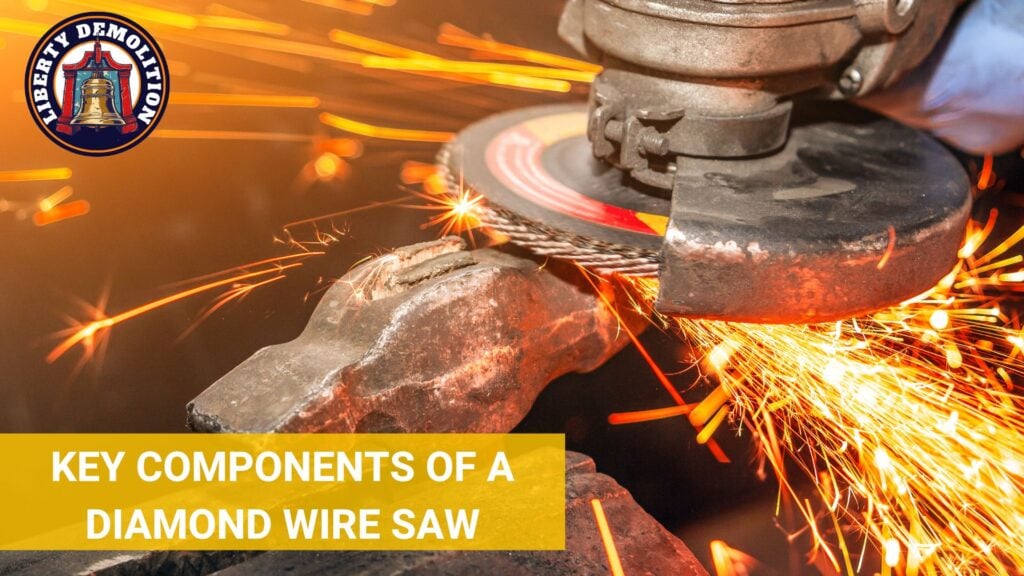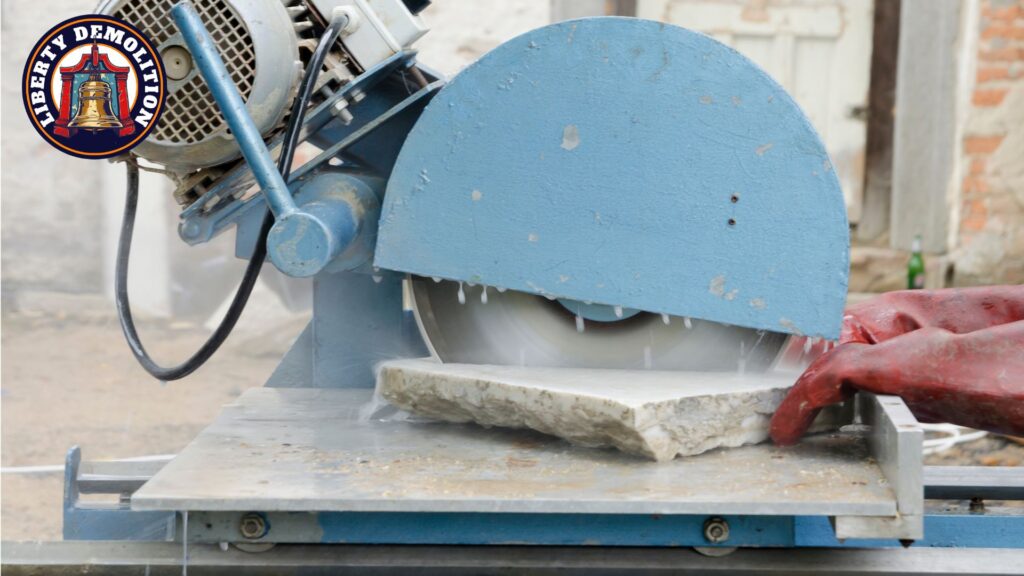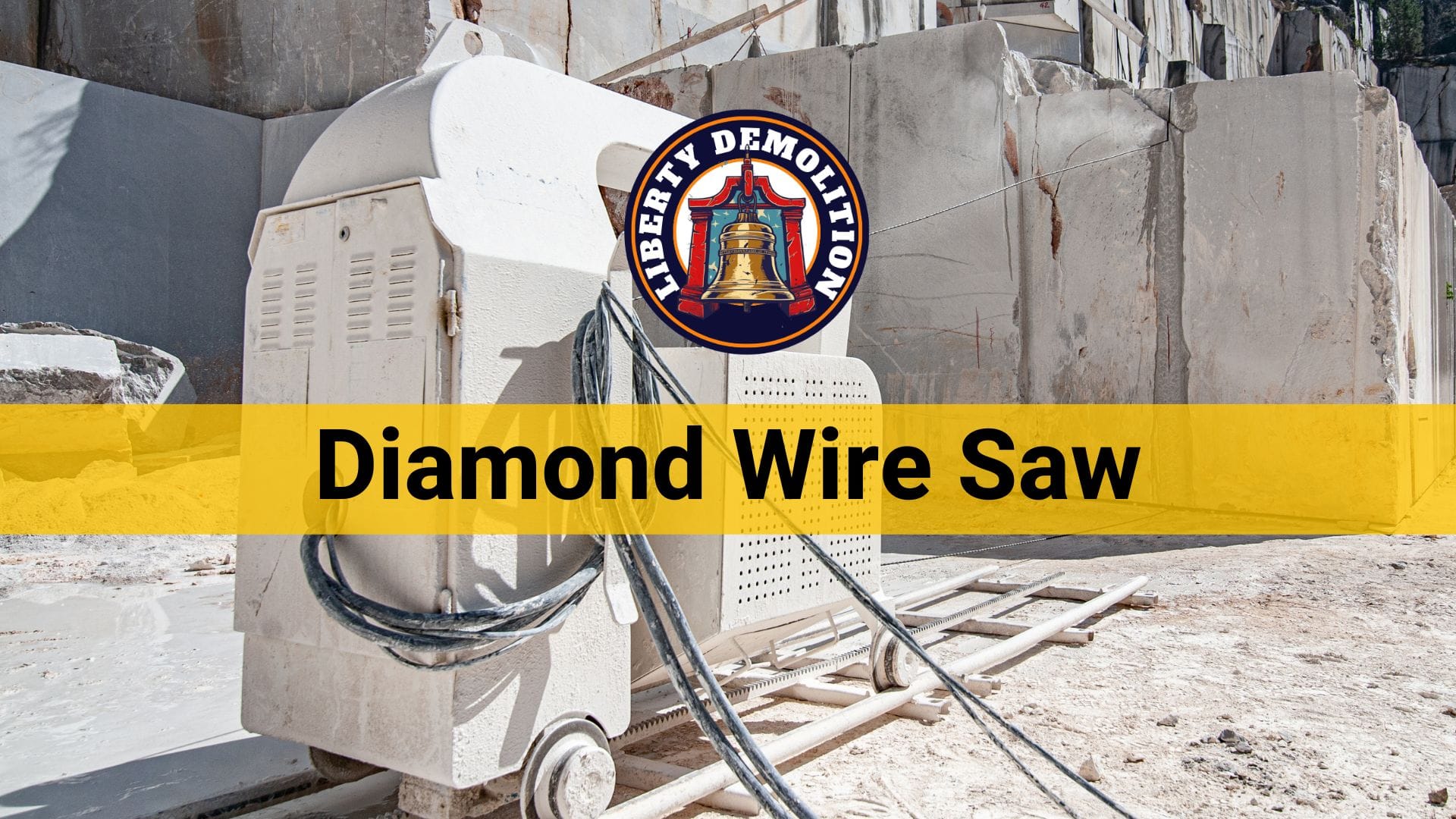A diamond wire saw is a tool used for cutting and slicing hard materials, with a metal wire embedded with diamond granules. Due to the hardness of diamonds, the saw can cut through stone, concrete, and other tough substances with precision.
Want to know more about how it works and where it’s used? Keep reading!
What Is a Diamond Wire Saw?
A diamond wire saw is a cutting device that uses a wire loop embedded with tiny diamond granules. These diamonds give the wire its cutting power and allow it to slice through some of the hardest materials known to man. The tool is designed for precision and is especially beneficial in industries where intricate and delicate cuts are needed.
The wire is often kept in constant motion when using the tool. It cuts through the material by abrasion rather than the typical sawing action. This method results in a cleaner cut with less waste.

Key Components of a Diamond Wire Saw
While various models might have additional features tailored for specific tasks, there are four primary components that are universally present and critical to the saw’s function.
1. The Diamond-Embedded Wire
This is the most important part of the tool. Unlike traditional saw blades that have teeth, this wire is embedded with tiny diamond granules. Diamonds, being the hardest natural substance, offer unparalleled cutting ability. They allow the wire to cut through hard materials effortlessly.
The wire is designed to be both flexible and durable. This flexibility allows it to make intricate cuts, navigate tight corners, and adapt to varying cutting scenarios. Simultaneously, its durability ensures that it doesn’t break or wear out quickly, even under the pressure of cutting tough materials.
Instead of using a sawing action, the diamond wire cuts through abrasion. As the wire moves, the embedded diamond granules grind against the material being cut. This abrasive action results in a clean and precise cut. Doing so reduces waste material and eliminates the jagged edges often left by traditional saws.
2. The Pulley System
The pulley system is what drives the diamond-embedded wire. It ensures that the wire remains in constant and continuous cutting action. Controlling and directing the diamond wire would be nearly impossible without the pulley system.
Typically, a diamond wire saw will have multiple pulleys. These pulleys guide the wire to maintain the right tension and trajectory. The wire is looped around these pulleys, and as they rotate, the wire is propelled forward, facilitating the cutting action.
A significant advantage of the pulley system is its adjustability. Operators can modify the tension of the wire, its speed, and sometimes even the angle of cutting by making adjustments to the pulley system. This flexibility is essential for tasks that require varying levels of precision or for materials that have different hardness levels.
3. The Driving Motor
Without the driving motor, the diamond-embedded wire wouldn’t move, and the saw would be ineffective. The motor’s primary function is to transfer power to the pulley system and enable the wire to cut through materials.
Different diamond wire saws come equipped with various motors tailored to the demands of the task at hand. Some may have electric motors, suitable for indoor or controlled environments, while others might have hydraulic motors, preferred for outdoor projects or places without a stable electrical supply.
The driving motor’s power and speed directly influence the tool’s performance. A more powerful motor can drive the wire through harder materials at a quicker rate. However, the speed of the motor can often be adjusted depending on the material being cut. For instance, softer materials might require a slower speed to achieve a precise cut, while harder materials might benefit from a faster speed to expedite the cutting process.
Like all mechanical components, the driving motor requires regular maintenance to ensure longevity and optimal performance. Cleaning, lubricating, and occasionally replacing worn-out parts can keep the motor running efficiently.
4. The Tensioning System
The tensioning system maintains the proper tension on the diamond-embedded wire. Proper tension is crucial for achieving clean, straight cuts. If the wire is too loose, it might not cut effectively, and if it’s too tight, it could snap.
This feature typically consists of springs or hydraulic systems that apply force to the wire to make sure it remains tight during the cutting process. This system often works in tandem with the pulley system and enables consistent tension throughout the wire’s length.
One of the significant benefits of the tensioning system is its adjustability. Operators can modify the tension based on the demands of the task. For example, cutting through thicker or harder materials might require more tension, while softer or thinner materials might require less.
The tensioning system also plays a crucial role in ensuring the safety of the diamond wire saw. Maintaining the right tension prevents the wire from snapping unexpectedly, which could lead to accidents or damage.
What Is a Diamond Wire Saw Used For?
The diamond wire saw, with its unique design and superior cutting ability, can be used in many tasks in different industries:
- Construction: For cutting through concrete, reinforced structures, and hard stones.
- Stone Quarries: In extracting natural stone blocks without causing cracks or breaks.
- Manufacturing: In industries where precise cuts of hard materials are required, such as electronics where silicon wafers are sliced.
- Underwater Operations: Due to its flexibility, it’s used for subsea cutting tasks, like pipeline or platform removals.
- Historical Building Renovations: Its precise and gentle cutting action ensures that original materials are preserved as much as possible. It allows restorers to remove damaged sections without compromising the integrity of the surrounding areas.
What Material Is a Diamond Saw Made of?
So what gives a diamond wire saw its ability to cut through the hardest materials?
1. Diamond Granules
Diamonds, known for being the hardest natural substance on Earth, are the primary cutting agents on a diamond wire saw. Natural diamonds are mined deep within the Earth’s mantle, while synthetic diamonds can be produced in laboratories. Synthetic diamonds are often preferred for industrial applications, including diamond wire saws, due to their consistent properties and cost-effectiveness.
Diamond granules used in wire saws are typically small and uniform. Their hardness allows them to scrape away and cut through almost any material. The diamonds’ sharp edges, combined with their toughness, ensure efficient and effective cutting.
2. Metal Wire
The metal wire serves as the base onto which diamond granules are embedded. This wire needs to be strong and flexible. It allows the saw to maintain tension and navigate through different cuts without snapping.
The wire is usually made of high-strength materials such as stainless steel or other durable metal alloys. These metals resist rusting and corrosion, which ensures longevity even under rigorous use.
The metal wire may have a multi-strand design to accommodate the diamond granules or feature a braided or twisted pattern. This design provides increased surface area and spaces for the diamond granules to be embedded to ensure an even distribution for consistent cutting.
3. Bonding Agents
Bonding agents are responsible for adhering the diamond granules to the metal wire. They must ensure the diamonds remain fixed to the wire during the cutting process. Various bonding agents can be used, including metal-based, resin-based, or electroplated bonds. The choice of bond often depends on the specific application of the diamond wire saw. For instance, metal-based bonds are durable and wear slowly, which makes them suitable for cutting harder materials. On the other hand, resin-based bonds might be preferred for softer materials or applications requiring a smoother finish.
4. Protective Coating
Some diamond wire saws come with a protective coating over the wire. This coating is meant to prevent premature wear and tear and protects the diamond granules and the metal wire. Protective coatings can be made of various substances, including specialized polymers or thin metal layers. These coatings offer additional resistance against abrasive materials, which help extend the lifespan of the wire saw.
Advantages of Using Diamond Wire Saws
Diamond wire saws have rapidly grown in popularity across various industries, largely due to their unique set of advantages. These benefits make them indispensable in tasks ranging from construction and masonry to artistry and precision manufacturing:
Precision and Control in Cutting
- Depth of Cut: Whether you’re looking to make a shallow incision or cut through an entire block, the tool allows for consistent depth throughout the process.
- Accuracy: Diamond wire saws can achieve precise cuts with minimal deviation due to their constant tension and adjustable speed. This precision is crucial in industries where even a small error can result in significant material wastage or compromised structural integrity.
- Clean Edges: The abrasive cutting action of the diamond granules ensures that the edges of the cut material are smooth. This minimizes the need for post-cut finishing or polishing, which helps in saving time and resources.
- Intricate Designs: The flexibility of the diamond-embedded wire allows it to navigate tight corners and complex geometries. It enables users to create intricate designs with ease. This is especially beneficial in industries like sculpture or custom stonework, where detail and finesse are important.
Ability to Cut Through Reinforced and Tough Materials
- Versatility in Material Choice: From granite and marble to concrete and ceramics, the diamond granules can slice through substances that many other cutting tools struggle with.
- Reinforced Structures: In construction and demolition tasks, diamond wire saws are often faced with cutting through reinforced concrete, which contains embedded steel bars for added strength. Traditional cutting tools might be hindered by these reinforcements, but diamond wire saws can effectively cut through both the concrete and the steel.
- Reduced Heat Production: Cutting tough materials often generates heat, which can affect the integrity of the material or even damage the cutting tool. The abrasive action of the diamond wire saw produces significantly less heat than traditional sawing methods to ensure both the material and the tool remain uncompromised.
- Safety: Being able to cut through tough materials also has safety implications. Operators can maintain a safer distance, especially when dealing with potentially hazardous materials or in situations where the material might crack or shatter using other cutting methods.
Reduction in Noise and Vibration
- Quieter Operations: Traditional cutting methods, especially when dealing with hard materials, can be quite noisy. This noise can be disruptive, especially in populated or residential areas. Diamond wire saws, in contrast, operate with significantly less noise. Their abrasive cutting action, which lacks the aggressive sawing or grinding of other tools, ensures quieter operations.
- Enhanced Comfort for Operators: The reduction in noise is not just beneficial for bystanders but also operators. Prolonged exposure to loud noises can harm one’s hearing and lead to fatigue. By minimizing noise, diamond wire saws enhance the comfort and safety of the operators.
- Minimal Vibration: Excessive vibration can lead to inaccuracies in the cutting process and can result in operator fatigue or even long-term health issues like Hand-Arm Vibration Syndrome. Diamond wire saws produce minimal vibrations, which results in more accurate cuts and the safety of the operators.
- Better Control: The steadiness of the tool ensures that the cuts are consistent and according to the desired specifications.
Minimal Dust Production
- Cleaner Cutting Process: Diamond wire saws’ abrasive action produces less dust than traditional saws. This results in a cleaner workspace and reduced cleanup time.
- Health and Safety Benefits: Respirable silica dust, a common byproduct when cutting through concrete or stone, can lead to serious respiratory conditions. By reducing dust production, diamond wire saws enhance the safety of the workspace and protect both operators and bystanders.
- Improved Visibility: Dust can also obstruct visibility, which makes it difficult for operators to see the cutting line or monitor the progress of the cut. Minimal dust ensures that operators have a clear view throughout the cutting process.
- Eco-friendly: Less dust means reduced environmental impact, especially in outdoor operations or sites near natural habitats.

Maintenance and Extending Wire Life
Properly maintaining a diamond wire saw can result in smoother operations, prolonged wire life, and cost savings in the long run. Here’s how to ensure the optimal performance and longevity of your saw:
Regular Inspection of the Wire for Wear
The diamond-embedded wire, being the primary cutting component, undergoes significant stress. Regularly inspecting it ensures early detection of wear or damage and prevention of potential tool breakdowns or sub-optimal performance.
Wear can manifest in several ways: thinning of the wire, uneven diamond distribution, or even visible damage such as fraying or breaks. Keeping an eye out for these signs can be the difference between a minor repair and a significant tool failure.
For users who operate the diamond wire saw regularly, it’s advisable to set a routine inspection schedule, whether after a specific number of hours of operation or at the end of each project. This ensures that the wire is always in optimal condition before the commencement of a task.
Proper Tensioning for Even Wear
Tension plays a critical role in the diamond wire Saw’s performance. Too little tension can lead to inefficient cutting, while too much can risk breaking the wire. Proper tension ensures that the wire wears evenly and extends its lifespan.
Most diamond wire saws come equipped with a tensioning system that allows operators to adjust the tension based on the material being cut and the specific task requirements. Regularly calibrating and ensuring this system is functioning correctly can lead to consistent and even wire wear.
If the wire is slipping, producing uneven cuts, or making unusual noises, it might be an indicator of improper tension. Addressing these signs promptly can extend the wire’s life and ensure cleaner cuts.
Cleaning and Storage Best Practices
After each use, it’s advisable to clean the diamond wire saw by removing any debris or accumulated material. This can be done using a soft brush or compressed air. A gentle solvent or cleaner might be necessary for more thorough cleaning, especially if the saw has been used with materials that can cause buildup.
Certain parts of the saw, especially around the pulley system and the tensioning mechanism, might require periodic lubrication. This ensures smooth operation, reduces wear, and prolongs the tool’s overall life.
When not in use, the diamond wire saw should be stored in a cool, dry place, away from direct sunlight or extreme temperatures. If the tool comes with a protective casing or cover, it’s best to use it to ensure the wire and other components are shielded from potential damage or contaminants.

Frequently Asked Questions
Here are the answers to some common questions about diamond wire saws:
Can a diamond wire cut wood?
Yes, a diamond wire saw technically has the ability to cut through wood. The abrasive action of the diamond granules can wear away at the wood, creating a cut.
However, it’s essential to note that using a diamond wire saw for wood might not be the most efficient or practical choice. Wood is softer than materials like stone or concrete, and other traditional saws are more suited for woodworking tasks. Using a diamond wire saw for wood might result in slower cuts and potential wastage of the diamond granules.
Can a diamond wire cut steel?
Yes, diamond wire saws can cut through steel. Diamonds are incredibly hard, ranking higher on the Mohs hardness scale than steel. Therefore, the diamond granules embedded in the wire can rub and cut through steel materials.
This capability is especially beneficial when dealing with reinforced concrete, which often has steel bars embedded within. The diamond wire saw can cut through both the concrete and the steel reinforcement.
However, when cutting solely through thick steel or metal, there might be other tools or cutting methods, like plasma or laser cutting, which could offer faster or cleaner results. The efficiency of a diamond wire saw on steel also depends on factors like the steel’s thickness, the diamond granules’ size, and the wire’s tension and speed.
How does a diamond wire saw differ from traditional saws?
The most notable difference is the cutting mechanism. While traditional saws rely on sharp teeth and a sawing action, diamond wire saws use an abrasive method, where the diamond granules grind against the material to create a cut.
Diamond wire saws are more flexible due to their wire design, which allows them to make intricate cuts, navigate tight spaces, and adapt to varying cutting scenarios. Traditional saws, especially those with rigid blades, might not offer the same level of adaptability.
Diamond wire saws are specially designed to cut through hard materials like stone, concrete, and ceramics. While traditional saws can handle a range of materials, they might struggle or wear out quickly when dealing with exceptionally hard substances.
Make the Right Cut 💎
From its precise cutting mechanism powered by diamond granules to its wide range of applications in various industries, a diamond wire saw has revolutionized how we approach tough material-cutting tasks. Its unique advantages, such as reduced noise, minimal dust production, and unmatched precision, make it an indispensable asset in numerous fields.
For those seeking top-notch demolition services done by professional demolition contractors in Philadelphia, the choice of tools and methodology matters. At Liberty Demolition, we recognize the importance of using the best tools, like the diamond wire saw, to ensure efficiency, precision, and safety.
If you’re looking for a seamless, eco-friendly, and precise demolition solution, Liberty Demolition is your trusted partner. Reach out to us today and experience the difference of working with industry leaders.






